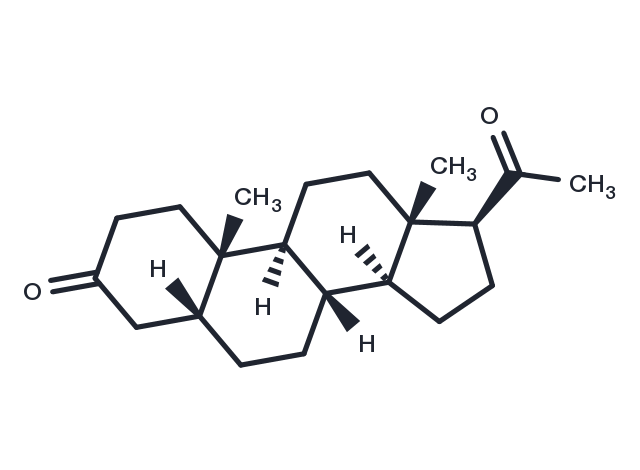Powder: -20°C for 3 years | In solvent: -80°C for 1 year


5β-Dihydroprogesterone (5β-DHP) is a progesterone receptor agonist and metabolite of progesterone .1,2It is formed from progesterone by 5β-reductase.25β-DHP inhibits spontaneous contractions in isolated rat uterus when used at a concentration of 10 μg/ml, an effect that can be blocked by the progesterone receptor antagonist RU486 but not the GABAAreceptor antagonist picrotoxin .1It is a negative modulator of homooligomeric Ρ1 subunit-containing GABAAreceptors, inhibiting GABA-induced currents inX. laevisoocytes expressing these receptors (IC50= 5.02 μM).3Plasma levels of 5β-DHP decrease at the onset of spontaneous human labor.4

| Pack Size | Availability | Price/USD | Quantity |
|---|---|---|---|
| 100 mg | Inquiry | $ 298.00 | |
| 500 mg | Inquiry | $ 798.00 |
| Description | 5β-Dihydroprogesterone (5β-DHP) is a progesterone receptor agonist and metabolite of progesterone .1,2It is formed from progesterone by 5β-reductase.25β-DHP inhibits spontaneous contractions in isolated rat uterus when used at a concentration of 10 μg/ml, an effect that can be blocked by the progesterone receptor antagonist RU486 but not the GABAAreceptor antagonist picrotoxin .1It is a negative modulator of homooligomeric Ρ1 subunit-containing GABAAreceptors, inhibiting GABA-induced currents inX. laevisoocytes expressing these receptors (IC50= 5.02 μM).3Plasma levels of 5β-DHP decrease at the onset of spontaneous human labor.4 |
| Molecular Weight | 316.485 |
| Formula | C21H32O2 |
| CAS No. | 128-23-4 |
Powder: -20°C for 3 years | In solvent: -80°C for 1 year
Chloroform: 30 mg/mL
You can also refer to dose conversion for different animals. More
bottom
Please see Inhibitor Handling Instructions for more frequently ask questions. Topics include: how to prepare stock solutions, how to store products, and cautions on cell-based assays & animal experiments, etc.
5β-Dihydroprogesterone 128-23-4 5beta-Dihydroprogesterone 5βDihydroprogesterone 5β Dihydroprogesterone 5b-Dihydroprogesterone inhibitor inhibit
